 Overview
Overview
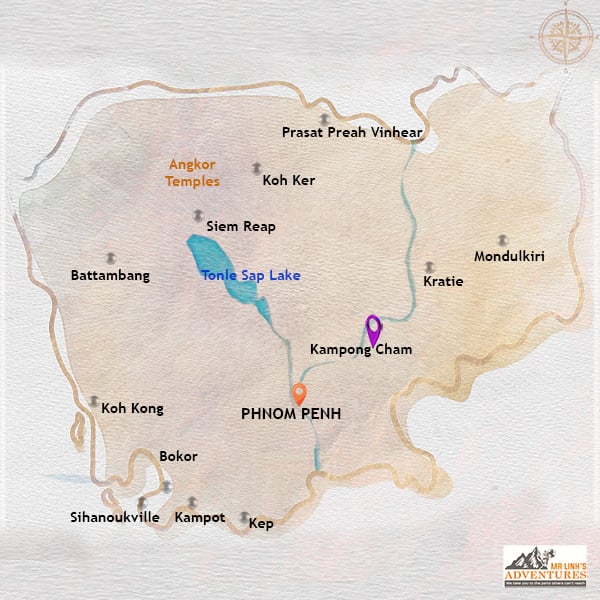
Welcome to
Kampong Cham, this charming rural oasis at the confluence of French colonial architecture and Khmer and Chinese influences. Far from the beaten path, this peaceful province immerses you in the heart of authentic Cambodia, marked by lively riverbanks, agriculture, and fishing.
Away from the hustle and bustle of Phnom Penh, Kampong Cham offers you an immersive and timeless experience. Let yourself be enchanted by the discovery of its hidden Angkorian temples, which will provide you with a unique glimpse into local life and rural Cambodia. Come and soak up its soothing atmosphere and bucolic charm, for a getaway off the tourist trail.
 Top Attractions
Top Attractions
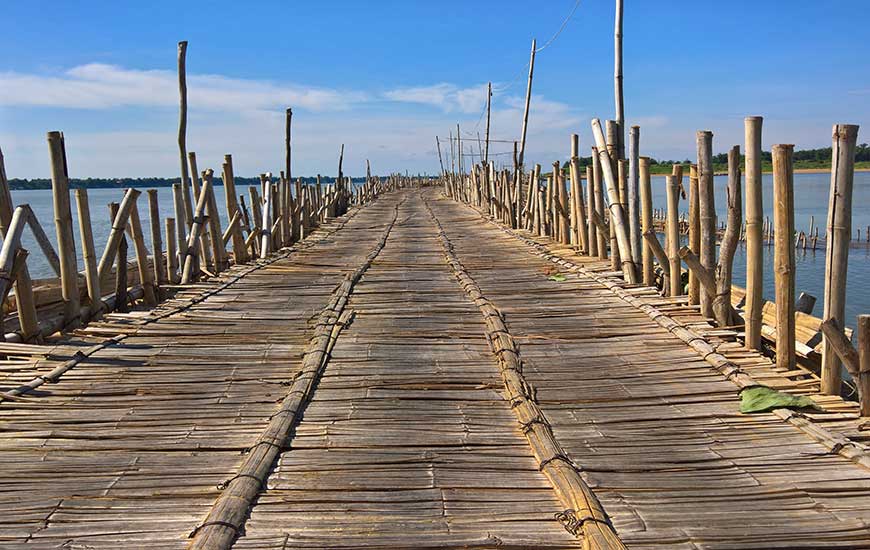 Koh Pen Bamboo Bridge is distinguished by its unique architecture
Koh Pen Bamboo Bridge is distinguished by its unique architecture
Kampong Cham, a peaceful town along the Mekong River, is full of treasures that invite you to discover and immerse yourself in local life. Here are not-to-be-missed experiences to explore its authentic charm:
The bamboo bridge (Koh Pen Bridge)
A true emblem of Kampong Cham, this handcrafted bamboo bridge is a marvel of ingenuity. Every year, after the rainy season, it is meticulously rebuilt by hand, linking the town to the peaceful island of Koh Pen. It's a great place for a leisurely stroll, offering unique photo opportunities and immersion in the daily lives of the locals who use it by motorcycle, bicycle or on foot. Crossing this bridge is an experience in itself!
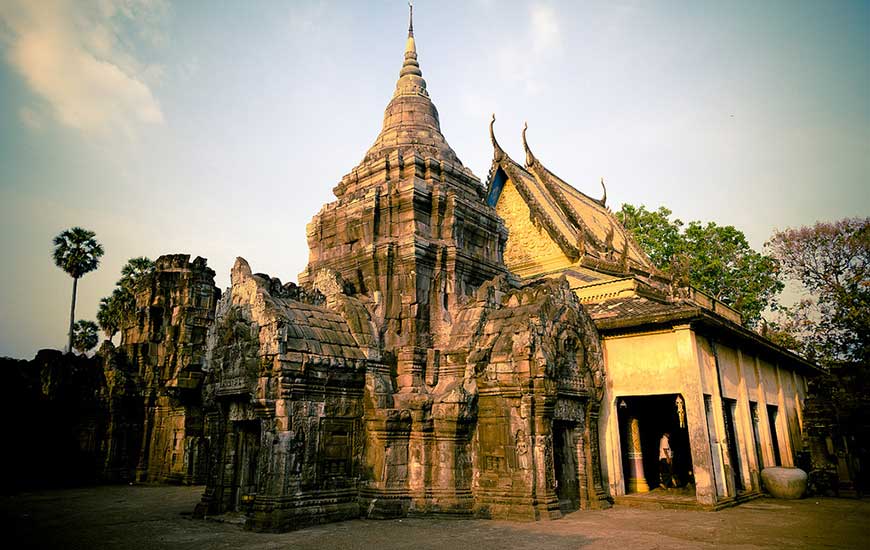 Wat Nokor Bachey, a captivating testament to Cambodia's rich historical mosaic
Wat Nokor Bachey, a captivating testament to Cambodia's rich historical mosaicWat Nokor Bachey
This historic Buddhist temple is a fascinating site that combines elements of 12th-century Angkorian architecture with a modern pagoda. Situated on a small hill, Wat Nokor offers not only an insight into Cambodian history and spirituality, but also a breathtaking panoramic view of the surrounding countryside. You'll discover impressive Buddha statues and a serene atmosphere conducive to contemplation.
Pepper farm
Kampong Cham is renowned for its quality pepper, and a visit to one of its farms is a great way to discover this flagship product. You can stroll through the lush plantations, learn about the various stages of pepper cultivation and production, and even taste and buy local products straight from the source. A sensory experience guaranteed!
Koh Pen Island
Accessible directly via the famous bamboo bridge (or by ferry during the rainy season), Koh Pen is a serene island on the Mekong, offering a true haven of peace. Far from the hustle and bustle of the city, it's the ideal place to rent a bike and explore rural Cambodian life. You'll discover farms, traditional houses on stilts, and bucolic landscapes perfect for relaxing, bathing in the Mekong and enjoying the surrounding nature. It's an authentic immersion in local culture and daily life.
 See & Do
See & Do
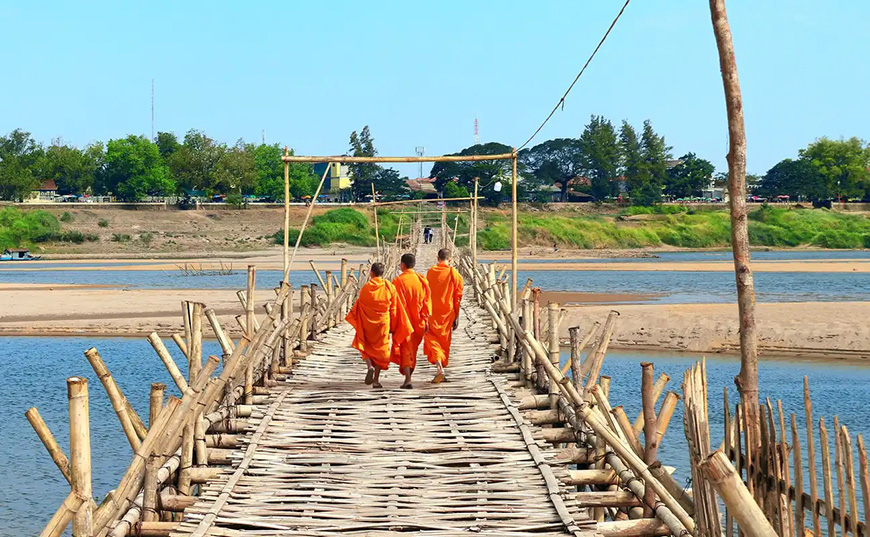 Koh Paen Island (or Koh Pen) sits in the middle of the Mekong River
Koh Paen Island (or Koh Pen) sits in the middle of the Mekong River
Kampong Cham, far from the tourist crowds, is a town that invites deep immersion in Cambodian authenticity. Here is a selection of activities to discover its unique charm and hidden treasures:
Cross the Bamboo Bridge and explore Koh Paen
The experience often begins with the bamboo bridge, a true symbol of Kampong Cham. Once a vital link spanning almost a kilometer and capable of supporting trucks and cars, it has been replaced by a more modern concrete structure. However, tradition lives on with a more modest bamboo bridge, now reserved for pedestrians and cyclists. Crossing it is an immediate immersion in the serene atmosphere of Koh Paen island.
Once on the island, let yourself be carried away by the tranquility of its small roads. Hire a bike and set off to meet the villagers and their traditional wooden houses on stilts. Soak up the local spirituality by visiting the peaceful Buddhist temples and enjoy a moment of relaxation on the local beach on the banks of the Mekong. It's the perfect opportunity to immerse yourself in rural Cambodian life.
Explore the hills of Phnom Srey and Phnom Pros
At the gateway to Kampong Cham, the hills of Phnom Srey and Phnom Pros offer a fascinating cultural and spiritual getaway. These "Women's Mountain" and "Men's Mountain" are steeped in local legend and home to colorful pagodas and stupas. The climb, though short, is rewarded with verdant panoramas of the surrounding countryside. It's an ideal place for a serene stroll and to soak up the region's history and spirituality.
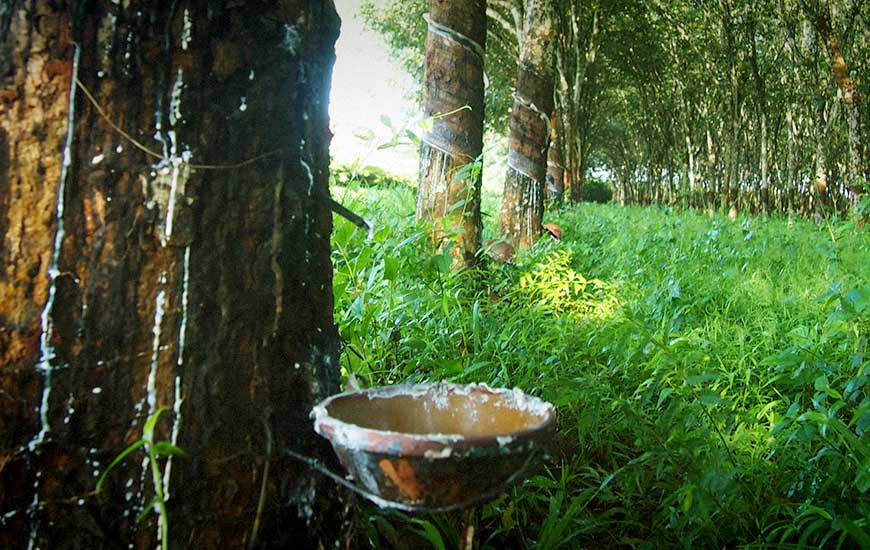 Kompong Cham was the heartland of the Cambodian rubber industry and plantations still stretch across the province
Kompong Cham was the heartland of the Cambodian rubber industry and plantations still stretch across the provinceDiscover the Rubber Plantations
Kampong Cham is at the heart of Cambodia's historic rubber-producing region. Explore the vast rubber plantations, a legacy of French colonization, and immerse yourself in the history and process of this age-old industry. See how latex is harvested from the tree and learn more about its processing. It's a fascinating immersion in an important aspect of the region's economy and history.
 Go Green
Go Green
Mr Linh's Adventures offers tours in Kampong Cham for all tastes:
Bike Tours: explore the surrounding countryside by bike, with local guides who will show you the hidden treasures of the region.
Boat Tours: sail on the Mekong and discover the river landscapes, fishing villages, and surrounding islands.
Combined Tours: combine cycling, boating, and trekking activities for a complete experience of Kampong Cham.
 Heritage
Heritage
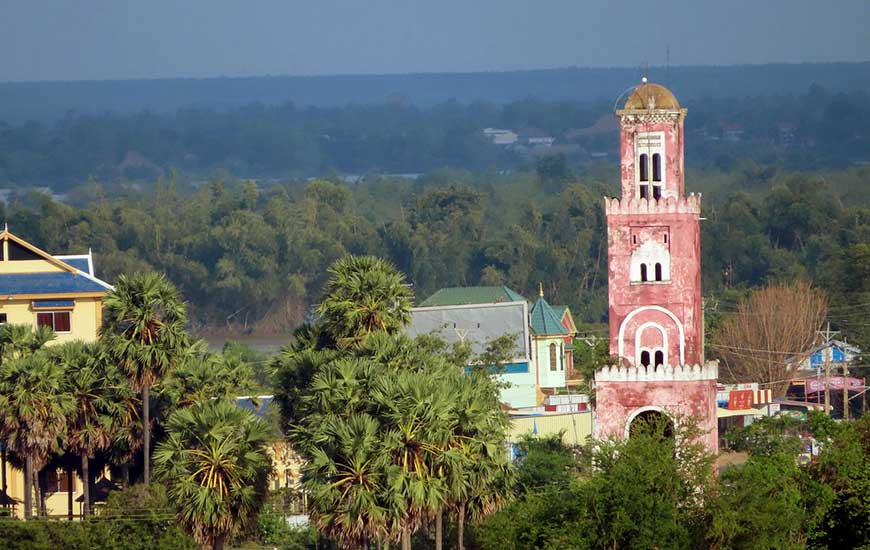 The French watch tower stands on the Mekong river opposite to Kampong Cham
The French watch tower stands on the Mekong river opposite to Kampong Cham
Immerse yourself in the fascinating history of Kampong Cham through its architectural gems!
The majestic Wat Nokor plunges you into the grandeur of the Khmer kingdom. Its central tower in black sandstone, rare in the region, reveals captivating scenes of Buddhist teachings. A true relic of a glorious past, this temple invites you to meditation and discovery.
Proudly overlooking the banks of the Mekong, the French colonial watchtower bears witness to Kampong Cham's strategic commercial role at the time. Climb its steep steps to enjoy an exceptional panorama of the city and its surroundings.
But the province also abounds in more discreet treasures, off the beaten path. Visit Wat Maha Leap, one of the few remaining wooden pagodas in Cambodia. Steeped in history, it has preserved its former splendor thanks to the monks who perpetuate tradition.
Finally, let yourself be enchanted by the serenity of Wat Hanchey, perched on its hill overlooking the Mekong. Its origins date back to the 8th century, offering a unique testimony to the cultural and spiritual richness of the region. An ideal place to recharge, contemplate the landscapes, and meditate.
Kampong Cham offers you a unique experience, at the crossroads of history, architecture, and spirituality.
 Food & Drinks
Food & Drinks
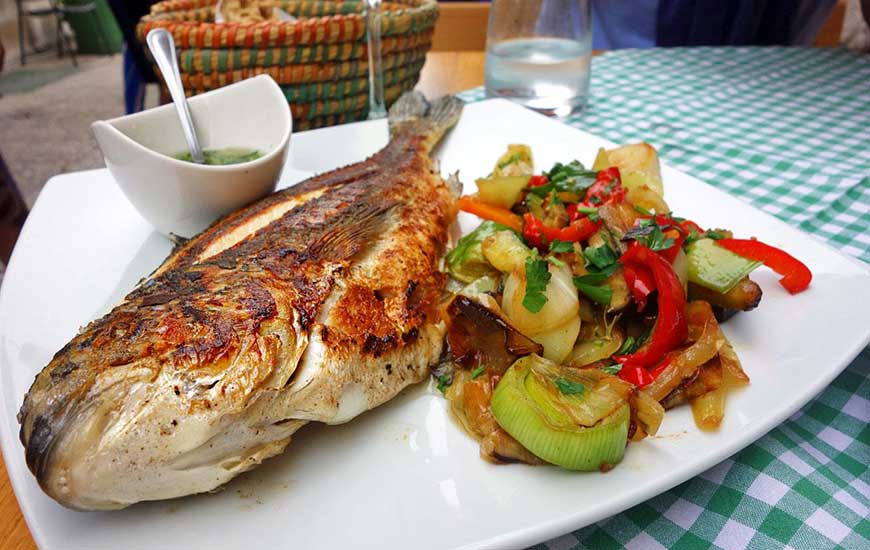 Kampong Cham offers an authentic and tasty culinary experience
Kampong Cham offers an authentic and tasty culinary experience
Kampong Cham, Cambodia's rural and agricultural province, offers an authentic and tasty culinary experience
Nom Banh Chok : fresh rice noodles served with a fish broth with coconut milk and herbs, garnished with fresh vegetables. The quintessential local breakfast.
Kuy Teav : light rice noodle soup with pork (or beef/seafood) and meatballs. A comforting dish, customizable to your taste.
Prahok Ktis :thick dip made with minced pork, coconut milk and prahok (fermented fish paste). Served with fresh vegetables, a daring experience.
Amok Trey:steamed fish mousse with curry, coconut milk and Khmer curry paste. Creamy, fragrant and mild, a refined national dish.
Fresh fruit and fruit juices
Enjoy fresh local fruit (mango, dragon fruit, rambutan) and freshly squeezed fruit juices, perfect for refreshing.
Finally, quench your thirst with fresh sugarcane juice, a popular and refreshing local beverage. Grown in the region, sugar cane is pressed and transformed into juice, offering a sweet and natural break as you stroll the streets of Kampong Cham.
 Directions
Directions
Location
Kampong Cham is located about 120 km northeast of Phnom Penh, the capital of Cambodia.
How to get there
From Hanoi: you can take a flight to Phnom Penh, then a bus or taxi to Kampong Cham.
From Ho Chi Minh City: you can take a flight to Phnom Penh, then a bus or taxi to Kampong Cham.
Best Season
The best time to visit Kampong Cham is from November to March, during the dry season, when the weather is pleasant and sunny.